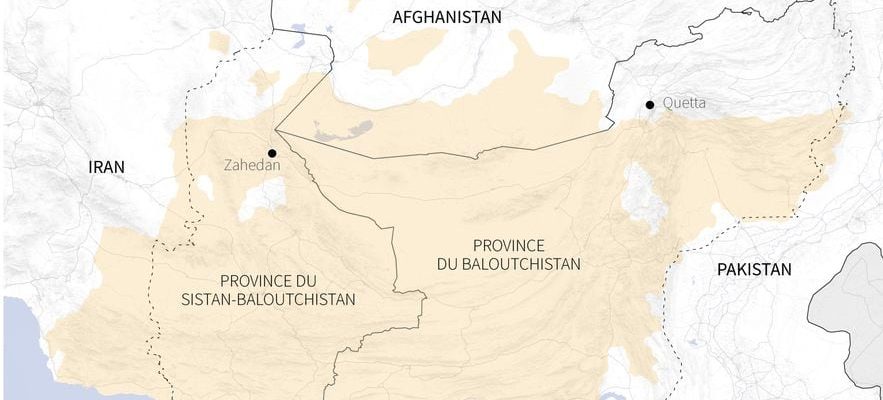It is little known to the media, but this area is a lot of talk in the Middle East. This is Baluchistan, an unstable region shared between Iran and Pakistan. This is where security forces on both sides of the border have been battling armed groups for years. To the point of causing a rise in tensions between the two neighbors at the level of a porous border of more than 900 kilometers.
On Thursday, January 18, Pakistan carried out a series of highly coordinated and specifically targeted precision strikes against terrorist hideouts in Sistan-Baluchistan province.
© / afp
Baluchistan, in the south-west of Pakistani territory, and Sistan-Baluchistan, in the south-east of Iranian territory, share a hostile geography: desert plains crushed by the summer heat, rocky mountains sometimes buried under the snow in winter, all in a seismic zone. With an area between them almost equal to that of France (527,000 km2 compared to 555,000), these regions are very sparsely populated and very poor: more than 15 million inhabitants live there between Pakistan and Iran, part of which belongs to the Baloch ethnic group, also present – but very much in the minority – in Afghanistan.
In this territory, tensions had rarely degenerated into attacks, as is the case today, Iran and Pakistan having each struck targets described as “terrorist” in their neighbor. Nine people were killed on Thursday, January 18, in Pakistani airstrikes, Tehran announced, two days after Iran targeted “terrorist” targets in Pakistan, killing at least two people. In their sights: the Sunni separatist group Jaish al-Adl (Army of Justice), blacklisted by Iran – but also by the United States – as a terrorist organization. In recent months, its members have carried out attacks in Iran. Eleven police officers were killed in an attack claimed by Jaish al-Adl in the town of Rask in December.
An armed rebellion in Balochistan
Whether in Iran or Pakistan, the Baloch are poorly perceived. They face discrimination in Iran because they are Sunnis, which makes them a minority in the Shiite Islamic republic. Marginalized, they suffer from abandonment by the State and their downgrading. Entire villages are without water or electricity.
For their part, Pakistani forces have also been fighting an ethnic Baloch separatist insurgency since 2004. Since its annexation to Pakistan in 1948, Baluchistan has been shaken by separatist upheavals. There have already been several uprisings. The demands are economic: the insurgents complain of not receiving a fair share of the wealth, in particular hydrocarbons, that its subsoil contains. It is also in Baluchistan that Pakistan is carrying out its nuclear tests.
While Balochistan supplies gas to the country, its population has the feeling that its wealth is being stolen, a feeling which reinforces pro-independence discourse. If this armed rebellion left hundreds dead in attacks which first targeted Pakistani security forces, the latter are in turn accused of repressing separatists, including peaceful ones, with Amnesty International denouncing “serious violations of human rights”. Man” in Balochistan. According to the NGO “Voice of the Missing Baloch”, tens of thousands of people have been kidnapped and thousands of corpses found since 2000, figures disputed by the Pakistani authorities.
Taking advantage of this instability, several jihadist groups, from the Islamic State to the Taliban, hid in Balochistan, where bloody attacks were committed, notably against the Hazaras, a Shiite ethnic group. Quetta, the capital of Balochistan, has long housed the main leadership body of the Afghan Taliban, “the Quetta Shura”, fueling Western accusations of support provided by Islamabad to this movement now in power in Afghanistan.
The strong repression of the Iranian regime
Sistan and Baluchistan faced further instability in late 2022, when its residents joined nationwide protests erupting in Iran following the death of Mahsa Amini, after she was arrested for violating the strict dress code imposed to women in the country. If the demonstrations in this Iranian province had their own origin – the alleged rape of a teenage girl by a police commander and the discrimination of which the population claims to be victims of the Shiite regime – they combined with national anger .
The repression was stronger there than elsewhere. On September 30, 2022, more than 80 people were killed, according to Amnesty International, when security forces opened fire on a protest in Zahedan, the main city of Sistan and Baluchistan. Members of this minority – which represents 2 to 6% of the Iranian population – were victims of a third of all executions carried out in Iran in 2022, according to the NGO Iran Human Rights.
